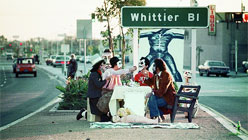State of Mind: New California Art circa 1970 at the University of California, Berkeley Art Museum and Pacific Film Archive challenges the viewer to invest time in the exhibition. Many of the more than 150 works on display are represented as time-based media, photography, and/or documentation of projects that were often informally realized fleetingly in public space. Grainy videos, photographs, and explanatory texts dominate the galleries, amidst displays of artists’ books and installations by some sixty artists; more than half spent formative years in the Bay Area. The payoff for the viewer lies in active reading rather than in passive looking: many of the objects on display require a larger context for full appreciation. Much of contemporary art production, one discovers when surveying so many heavy hitters, owes a debt to California conceptual art from the 70s.
Conceptual art is loosely defined by an emphasis on ideas over aesthetics or objects. In other words, the idea is the artwork. Bruce Nauman’s 1969 Video Corridor for San Francisco (Come Piece) is a pair of video cameras that feed into two video monitors installed on opposite ends of the room, set diametrically on the floor. Walking through the installation, your image might be caught briefly on a monitor, mostly if you aren’t trying to make it happen. If you try to orchestrate it, you will have less success. As an object, Nauman’s Video Corridor for San Francisco (Come Piece) is unremarkable; given the rapid antiquity of technology, the monitors aren’t even compelling equipment. It is the unfolding experience of the idea on display here that engages, some works with more poignancy than others.
Oil 1969, a performance by Joe Hawley, Mel Henderson and Alfred Young, involved spelling out the word ‘oil’ with nontoxic dye on the San Francisco Bay, near the Standard Oil refinery in Richmond, California. It doesn’t matter that only a handful of people would have seen the work live — or would have even known it was an artwork upon seeing it — the timeless concept takes root in our imagination. Our ongoing political strife around oil, anticipated in this work, makes the sentiment salient today. The same artists also created a traffic jam in downtown San Francisco with Yellow Cabs 1969 by calling one hundred yellow cabs to the same destination at the same time. To be sure, Yellow Cabs is humorous, but it is also slyly simple in its execution. So too was Lynn Hershman’s The Dante Hotel 1973-74, a yearlong mixed-media installation in a San Francisco SRO hotel room wherein the artist bypassed institutional invitation by presenting her work independently. In the exhibition, we see a receipt and images — we don’t see the installation. It doesn’t matter — the idea transcends presence.
East Los Angeles collective Asco (Harry Gamboa Jr., Patssi Valdez, Gronk and Willie Herron III) created overtly political work in the streets, such as First Supper (After a Major Riot) in 1974. Represented here as performance documentation, the collective staged a Christmas Eve meal, with elaborate costumes and props, at the site of a deadly police altercation and major Los Angeles traffic island on Whittier Boulevard. Less ostentatious, but in the same spirit, Bonnie Sherk’s Sitting Still Series from 1971 documents the artist serenely sitting in the midst of city sites such as the Financial District, near the construction of the 101 Freeway Interchange, and on the Golden Gate Bridge. These works emphasized the potential to shift perceptions of public space. Beyond documentation, State of Mind offers an extensive profile of resistance strategies that artists used to work around political and institutional confines still recognizable today. May some of these simple gestures resonate with visitors as replicable acts of rebellion in the present.
State of Mind: New California Art circa 1970 is on view at University of California, Berkeley Art Museum and Pacific Film archive through June 17, 2012. For more information, visit www.bampfa.berkeley.edu.


